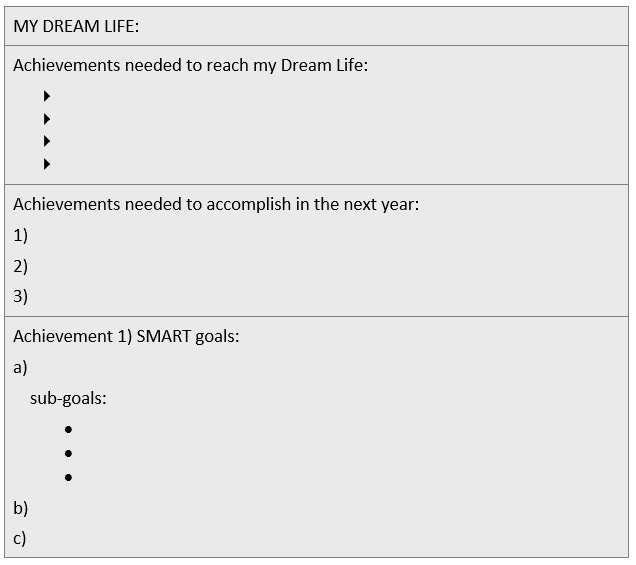This article is part of a series of articles on 5 Key Principles for Intentional Living. This article explains what SMART goals are and how to create them. It also provides a SMART goal template and SMART goal examples.
Achieving your ideal life starts with planning and setting SMART goals
As you focus on designing an intentional life and work toward implementing your ideal life, it is important to incorporate planning and setting SMART goals. Achieving your ideal life may seem daunting right now, but if you break it down into smaller goals and accomplishments, and create a realistic plan, it won’t feel so out of reach.
What will you need to accomplish between now and your end goal? If you determine the specific accomplishments you will need in order to create your ideal life, and then break those down into smaller goals, you will be on your way to implementing your intentionally designed life.
Using my newly designed life as an example
Let’s use my life as an example. Five years ago, I had a dream of quitting my job and taking at least 3 years off to travel full-time and to write. I knew I had to get intentional about planning for this new life, and through planning and goals setting I was able to achieve this dream in 2017. I had a five-year plan, and the elements of this plan included reaching the following achievements:
- Continue to develop professionally in my field and apply for and receive a promotion at work to both increase my skills and my income
- Purchase a second investment rental house, renovate it, and rent it to increase my rental income
- Build up my savings to $36,000 to supplement my rental income for the first three years of my new life of travel and writing
For each element of the overall plan, I had smaller achievements and goals. For each goal, I made sure they were SMART goals – specific, measurable, achievable, realistic, and time bound.
SMART goal elements
S – Specific (detailed and clear, desired accomplishment)
M – Measureable (clear outcome desired, how I will know when I achieved the goal)
A – Achievable (realistic, challenging but manageable)
R – Realistic (similar to achievable, this is a goal I can realistically achieve)
T – Time bound (due date & milestones, shoot for an ambitious timeline that motivates)
A non-SMART goal example: I want to save more money. There is nothing specific or measurable about this goal, and it is not clear how it will be achieved or when it will be achieved.
A SMART goal example: To save an additional $400 dollars each month to help meet my savings goal of $36,000 by 2017.
This SMART goal was pretty big and long term, so I broke it up into smaller SMART goals. For example, how was I specifically going to save $400 per month? I knew that in order to achieve this, I needed to make some changes to my spending habits. At the time, I wasn’t paying much attention to my spending. I knew I had to start creating and sticking to a budget. Thus, my smaller SMART goal was to subscribe to and download the You Need A Budget (YNAB) app on my phone, and to set up a budget by the end of the month for the following month. My goal also included entering my spending daily into YNAB and reviewing my budget once a week.
It worked! In the first month, I was able to cut $400 from our typical household spending per month and transfer that into savings. Another positive outcome from using YNAB was it gave me a realistic understanding of how much money I would need each month while living my new life, and it was less than I had originally thought!
A smaller SMART goal related to my bigger goal of receiving a promotion at work was to work toward a key certification in my field. This certification would give me a leg up when applying for that promotion. I broke that goal into smaller SMART goals. For example, study 1 hour a day for 10 weeks, in order to pass the certification exam on the first try.
YOUR TURN: Fill out the SMART Goal Worksheet for one goal that will help you reach one of your larger goals.
SMART Goal Template
Describe the goal, and be SPECIFIC:
What is the MEASURABLE outcome of the goal:
Is the goal ACHIEVABLE:
Is the goal REALISTIC:
When will the goal be achieved (TIME BOUND):
Once you are clear on the elements of your ideal life and the specific achievements needed to get there, you can start creating the smaller SMART goals to get you there. To get started, pick one element and determine what you need to do this month to help you move closer to that achievement. Then, ask yourself, “What do I need to do this week?” Last, “what do I need to do tomorrow?”
Create Your Plan
Grab your notebook, a large sheet of paper, or whiteboard. Use the following template to create a plan that includes SMART goals for this year.
Dream Life Planning Template

What is one SMART goal you can start working on right away? If you’re willing, share your SMART goal in the comment box below.

4 Thoughts on “Achieving your ideal life starts with planning and setting SMART goals”
Comments are closed.